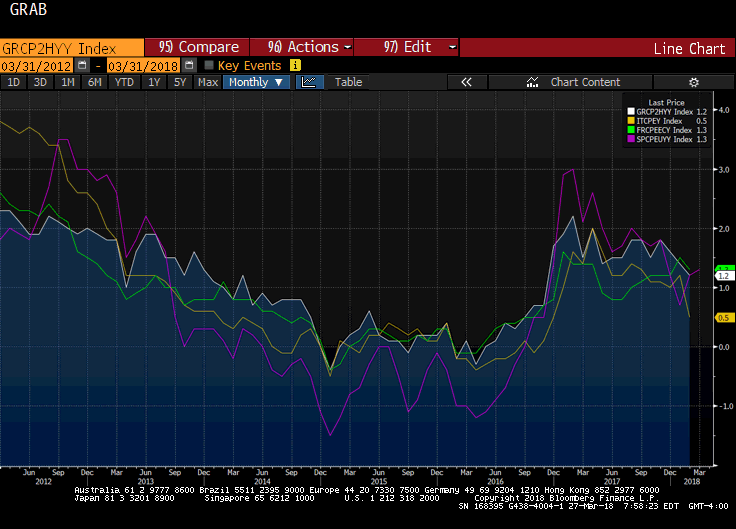The Reserve Bank of New Zealand is credited with being the first central bank to adopt a formal inflation target. Following last year’s election, the central bank’s mandate has been modified to include full employment. To be sure this was a political decision, and one that initially saw the New Zealand dollar retreat. The dual mandate that originated with the Fed has been questioned in the US, but Congress has shown little enthusiasm for changing it. The dual mandate would seem to give officials greater flexibility. The ECB in contrast focuses exclusively on inflation, and as we shall see, this may pose a challenge for communicating an end to its asset purchases. The Great Graphic shows the harmonized measure of CPI
Topics:
Marc Chandler considers the following as important: 4) FX Trends, ECB, EMU, Featured, Federal Reserve, Great Graphic, Inlfation, newsletter
This could be interesting, too:
Nachrichten Ticker - www.finanzen.ch writes Die Performance der Kryptowährungen in KW 9: Das hat sich bei Bitcoin, Ether & Co. getan
Nachrichten Ticker - www.finanzen.ch writes Wer verbirgt sich hinter der Ethereum-Technologie?
Martin Hartmann writes Eine Analyse nach den Lehren von Milton Friedman
Marc Chandler writes March 2025 Monthly
| The Reserve Bank of New Zealand is credited with being the first central bank to adopt a formal inflation target. Following last year’s election, the central bank’s mandate has been modified to include full employment. To be sure this was a political decision, and one that initially saw the New Zealand dollar retreat.
The dual mandate that originated with the Fed has been questioned in the US, but Congress has shown little enthusiasm for changing it. The dual mandate would seem to give officials greater flexibility. The ECB in contrast focuses exclusively on inflation, and as we shall see, this may pose a challenge for communicating an end to its asset purchases. The Great Graphic shows the harmonized measure of CPI for the four largest EMU countries: Germany (white), Italy (yellow), France (green), Spain (fuchsia). Spain released its preliminary March CPI earlier today. The year-over-year pace rose to 1.3% from 1.2%. The median forecast in the Bloomberg survey was for a rise to 1.5%. The preliminary report does not distinguish core prices, but it is possible that the core rate eased a touch. The rise of the headline rate may have been the result of the base effect related to electricity and gas costs. |
Germany, Italy, Fance and Spain HICP, March 2012 - 2018 |
Germany reports its preliminary March on Thursday, followed by France and Italy on Friday. German headline inflation is expected to rise to 1.6% from 1.2%. France is expected to increase to 1.5% from 1.3%, and Italy from 0.5% to 0.8%.
Next week, the eurozone’s preliminary estimate will be reported. It is expected to have ticked up to 1.4% from 1.2%, while the core is expected to have risen to 1.1% from 1.0% where it was in January and February. It was last at 1.1% last September, having peaked in April and July 2017 at 1.2%. If there is disappointment it could be that the core rate was unchanged. The headline rise may be traced to energy, food, and non-alcoholic drinks.
Also, despite the continued decline in unemployment, labor costs (which include wages and indirect benefits) rose 1.5% in Q4 17, the weakest in a three-quarters. This is a similar conundrum facing the US and Japan, where the relative tightness of the labor market is not spurring the increase in wages that economists project.
Within EMU, sustained inflation differentials are part of the changing competitive landscape. Lower inflation in Italy, for example, than Germany, is tantamount for an appreciation of the German euro and the depreciation of the Italian euro.
The Federal Reserve could exit its QE, raise interest rates and allow its balance sheet to begin shrinking despite price pressures remain below target. This is because of the Fed’s dual mandate. With unemployment (and growth) exceeding targets (full employment, trend growth) the Fed appeared willing to accept below target inflation.
It is more difficult for the ECB with its single mandate to look past below target inflation. Early last year, when headline CPI hit 2.0%, the ECB simply tapered its bond buying to 60 bln euros from 80 bln. It did not judge price pressures to be sustained. It is possible that even with a lower level of price pressures, it judges inflation to be more durable. However, the rhetorical flourishes needed, especially, if the weakness in the survey and sentiment indicators over the past three months is sustained and confirmed by real sector data.
Two ECB officials Praet and Liikanen have cautioned against premature ECB tightening. Praet is opposed to changing the language on stimulus. He expressed surprise by the influx of new workers that could be suppressing wages and prices. Liikanen cautioned that price pressures are lower than expected. He argued that the case for gradual tightening of monetary policy is more compelling if ”indications of inflation rates to potentially temporarily exceed 2% become more prominent in inflation expectations.” Bundesbank President Weidmann argued earlier this week that inflation is predicted to be in line with the ECB’s goal in 2020 and this alone warrants the start of normalization soon.
Our concern is that by the time the ECB begins normalizing monetary policy, the economy would be past its peak. This will limit the pace and extent of the normalization process. It begins with the deposit rate at minus 40 bp. Even if it begins to gradually hike beginning near the middle of 2019, how much above zero will rates get if growth returns to trend or lower? If make some conservative assumptions about Fed policy with two hikes in the remainder of this year and two next year, peak divergence still lies ahead.
Tags: ECB,EMU,Featured,Federal Reserve,Great Graphic,Inlfation,newsletter

